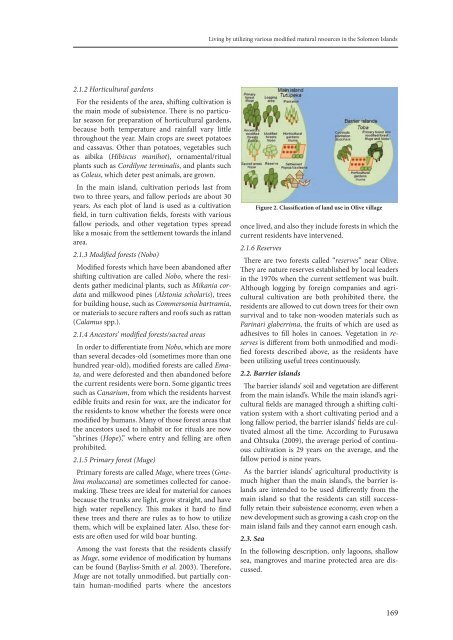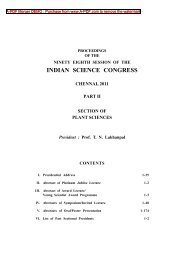sustainable use of biological diversity.pdf - India Environment Portal
sustainable use of biological diversity.pdf - India Environment Portal
sustainable use of biological diversity.pdf - India Environment Portal
Create successful ePaper yourself
Turn your PDF publications into a flip-book with our unique Google optimized e-Paper software.
Living by utilizing various modified matural resources in the Solomon Islands<br />
2.1.2 Horticultural gardens<br />
For the residents <strong>of</strong> the area, shifting cultivation is<br />
the main mode <strong>of</strong> subsistence. There is no particular<br />
season for preparation <strong>of</strong> horticultural gardens,<br />
beca<strong>use</strong> both temperature and rainfall vary little<br />
throughout the year. Main crops are sweet potatoes<br />
and cassavas. Other than potatoes, vegetables such<br />
as aibika (Hibiscus manihot), ornamental/ritual<br />
plants such as Cordilyne terminalis, and plants such<br />
as Coleus, which deter pest animals, are grown.<br />
In the main island, cultivation periods last from<br />
two to three years, and fallow periods are about 30<br />
years. As each plot <strong>of</strong> land is <strong>use</strong>d as a cultivation<br />
field, in turn cultivation fields, forests with various<br />
fallow periods, and other vegetation types spread<br />
like a mosaic from the settlement towards the inland<br />
area.<br />
2.1.3 Modified forests (Nobo)<br />
Modified forests which have been abandoned after<br />
shifting cultivation are called Nobo, where the residents<br />
gather medicinal plants, such as Mikania cordata<br />
and milkwood pines (Alstonia scholaris), trees<br />
for building ho<strong>use</strong>, such as Commersonia bartramia,<br />
or materials to secure rafters and ro<strong>of</strong>s such as rattan<br />
(Calamus spp.).<br />
2.1.4 Ancestors’ modified forests/sacred areas<br />
In order to differentiate from Nobo, which are more<br />
than several decades-old (sometimes more than one<br />
hundred year-old), modified forests are called Emata,<br />
and were deforested and then abandoned before<br />
the current residents were born. Some gigantic trees<br />
such as Canarium, from which the residents harvest<br />
edible fruits and resin for wax, are the indicator for<br />
the residents to know whether the forests were once<br />
modified by humans. Many <strong>of</strong> those forest areas that<br />
the ancestors <strong>use</strong>d to inhabit or for rituals are now<br />
“shrines (Hope),” where entry and felling are <strong>of</strong>ten<br />
prohibited.<br />
2.1.5 Primary forest (Muge)<br />
Primary forests are called Muge, where trees (Gmelina<br />
moluccana) are sometimes collected for canoemaking.<br />
These trees are ideal for material for canoes<br />
beca<strong>use</strong> the trunks are light, grow straight, and have<br />
high water repellency. This makes it hard to find<br />
these trees and there are rules as to how to utilize<br />
them, which will be explained later. Also, these forests<br />
are <strong>of</strong>ten <strong>use</strong>d for wild boar hunting.<br />
Among the vast forests that the residents classify<br />
as Muge, some evidence <strong>of</strong> modification by humans<br />
can be found (Bayliss-Smith et al. 2003). Therefore,<br />
Muge are not totally unmodified, but partially contain<br />
human-modified parts where the ancestors<br />
figure 2. classification <strong>of</strong> land <strong>use</strong> in olive village<br />
once lived, and also they include forests in which the<br />
current residents have intervened.<br />
2.1.6 Reserves<br />
There are two forests called “reserves” near Olive.<br />
They are nature reserves established by local leaders<br />
in the 1970s when the current settlement was built.<br />
Although logging by foreign companies and agricultural<br />
cultivation are both prohibited there, the<br />
residents are allowed to cut down trees for their own<br />
survival and to take non-wooden materials such as<br />
Parinari glaberrima, the fruits <strong>of</strong> which are <strong>use</strong>d as<br />
adhesives to fill holes in canoes. Vegetation in reserves<br />
is different from both unmodified and modified<br />
forests described above, as the residents have<br />
been utilizing <strong>use</strong>ful trees continuously.<br />
2.2. Barrier islands<br />
The barrier islands’ soil and vegetation are different<br />
from the main island’s. While the main island’s agricultural<br />
fields are managed through a shifting cultivation<br />
system with a short cultivating period and a<br />
long fallow period, the barrier islands’ fields are cultivated<br />
almost all the time. According to Furusawa<br />
and Ohtsuka (2009), the average period <strong>of</strong> continuous<br />
cultivation is 29 years on the average, and the<br />
fallow period is nine years.<br />
As the barrier islands’ agricultural productivity is<br />
much higher than the main island’s, the barrier islands<br />
are intended to be <strong>use</strong>d differently from the<br />
main island so that the residents can still successfully<br />
retain their subsistence economy, even when a<br />
new development such as growing a cash crop on the<br />
main island fails and they cannot earn enough cash.<br />
2.3. Sea<br />
In the following description, only lagoons, shallow<br />
sea, mangroves and marine protected area are discussed.<br />
169
















